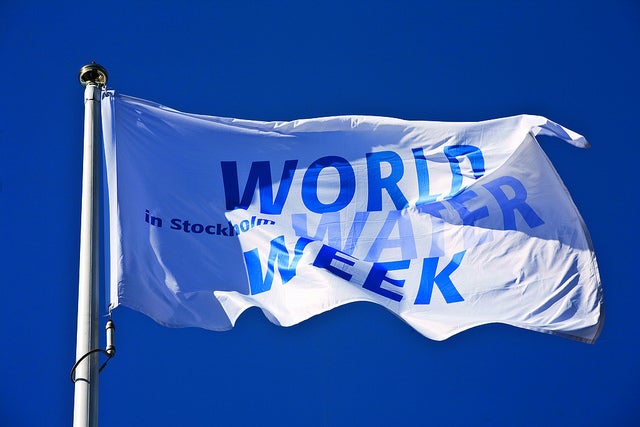2014 is the Year of the Energy-Water Nexus

2014 is shaping up to be the year of the energy-water nexus. First, the United Nation’s World Water Day centered on this topic. Then, the U.S. Department of Energy released a 250-page report on the energy-water nexus and indicated that it will be included in its Quadrennial Energy Review. And, this week, the biggest international water conference, World Water Week, is taking on the nexus.
Held every year in Stockholm, Sweden, World Water Week is led by the Stockholm International Water Institute (SIWI) and serves as a platform for over 200 collaborating organizations and 2,500 participants from 130 countries around the world to discuss global water and development issues.
In choosing the energy-water nexus as this year’s theme, SIWI and its supporters are affirming – on a global stage – what policy experts have been saying for years: energy and water are inextricably linked, and the best way to set the energy-water system on a sustainable course is to plan for both resources holistically.
In order to inform discussions and encourage collaboration among energy and water professionals at the World Water Week event, SIWI released: “Energy and Water: The Vital Link for a Sustainable Future”. This paper analyzes key opportunities and challenges facing the energy and water communities, including shale gas fracking, sustainable hydropower, and the importance of forests to proper energy and water co-management. But there were two chapters in particular that I hope will spark productive conversations at the event: Water and Energy: A Necessary Evolution from Dialogue to Partnership? and Water and Energy in the Urban Setting.
Asymmetries between water and energy
While the connection between the energy and water sectors is clear, there are considerable asymmetries in how the two are priced, regulated, and managed. Furthermore, it is no longer possible for each sector to simply talk about the other; they must work together to address the nexus.
For example, much of the electricity market is deregulated and run by large private companies participating in regional, national, or global markets, whereas the water sector is generally run by small public utilities operating in highly-regulated markets at the local level. Also, although energy efficiency is a central part of the energy sector, inefficient use of water seems to be the norm. Finally, energy is clearly priced and there is an awareness of pricing in the market and among customers, especially at the industrial level. Water, on the other hand, is typically not something we worry about: Not only is customer awareness of water prices low, but the way water is priced in the U.S. is not reflective of its true value.
This disparity lies at the heart of what makes the energy-water nexus so challenging. My hope is that the leaders of this year’s World Water Week conference focus on addressing these asymmetries, because doing so is the first step toward addressing many of the other challenges outlined in SIWI’s paper.
Cities may face conflict over energy-water nexus
Another key theme the paper covers is the need to address energy and water trade-offs in cities. We often hear about the water needs of agriculture, which is important, but with urban populations expected to double globally by 2050, we will face conflict over whether cities or power plants get the water if we’re not careful.
To some degree, this is locational. For example, Southern California has a very high water-associated energy demand because its water has to be pumped in from Northern California – a problem that could intensify as northern water sources are constrained by the state’s historic drought. As climate change exacerbates our water shortages, particularly in areas that are already water-stressed, cities may be forced to pursue a similar approach, looking outside of their own districts for water resources. This additional transportation of water could increase energy demand overall, which would, in turn, increase demand for water, creating a vicious cycle in the energy-water nexus spiral.
A more systematic approach to the water and energy needs of a city could help maximize efficiencies in both sectors and manage the scarce existing resources. The City of San Antonio offers a good example of effective energy-water co-management; San Antonio Water System (SAWS) prioritizes energy management and has won numerous awards for its energy savings. The water utility’s most innovative project to date is Dos Rios, a combined sewage treatment and biogas plant that reduces harmful air pollution and generates revenue from the sale of biogas. CPS Energy, the city’s progressive, municipally-owned electric utility, even installed a large, 20-megawatt solar farm at the facility to further cut harmful pollution and water use.
Each sector must view the other as a vital component of their collective futures: water is an energy resource and energy is a water resource. Equalizing the way we regulate and price the two is a step toward approaching these massive problems in a more systematic way.
Other water-stressed countries are thinking about this in innovative ways, so there’s no reason for the U.S. to reinvent the wheel. Over the next few months, I will be looking at some policies and strategies other countries are using to address their own energy-water nexuses. World Water Week is just the start, and there are still four more months left in the year to solidify 2014 as “the year of the energy-water nexus.”
If you are interested in learning more about how energy and water are fundamentally intertwined and what this means for our future, please join Kate Zerrenner and Dominique Gomez of WaterSmart Software for a Twitter chat on September 3rd from 12:30-1:30pm CST.











